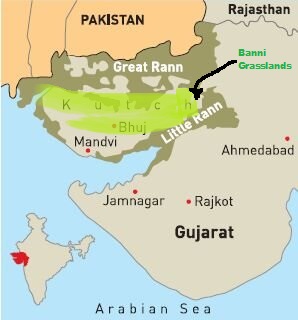From UPSC perspective, the following things are important :
Prelims level: Banni Grasslands of Kachchh

Why in the News?
A study conducted by researchers at Kachchh University assessed the suitability of different areas in Banni for sustainable grassland restoration, with ecological value being the primary criterion.
Restoration of Banni Grasslands: Highlights of the StudyRecent Study:
|
About Banni Grasslands:
- The Banni Grassland is a salt-tolerant ecosystem located in the Kutch district of Gujarat, covering around 3,847 square km.
- It is said to be Asia’s largest grassland (TOI).
- The climate is arid and semi-arid, with extremely hot summers (temperatures above 45°C) and mild winters (12°C to 25°C), receiving 300-400 mm of annual rainfall mainly during the monsoon.
- It is inhabited by pastoral communities like the Maldharis, who rely on livestock grazing (cattle, buffalo, and sheep) for their livelihood.
- Agriculture is limited due to arid conditions, with some areas used for salt production.
- Flora: Grasses such as Dichanthium, Sporobolus, and Cenchrus species, with salt-tolerant plants, shrubs, and trees like Acacia and the invasive Prosopis juliflora.
- Fauna: Indian wolf, hyena, chinkara, Great Indian Bustard, flamingos, and various raptors, reptiles, and invertebrates.
PYQ:[2021] The vegetation of Savannah consists of grassland with scattered small trees, but extensive areas have no trees. The forest development in such areas is generally kept in check by one or more or a combination of some conditions. Which of the following are such conditions? 1. Burrowing animals and termites 2. Fire 3. Grazing herbivores 4. Seasonal rainfall 5. Soil properties Select the correct answer using the code given below. (a) 1 and 2 (b) 4 and 5 (c) 2, 3 and 4 (d) 1, 3 and 5 |
Get an IAS/IPS ranker as your 1: 1 personal mentor for UPSC 2024

